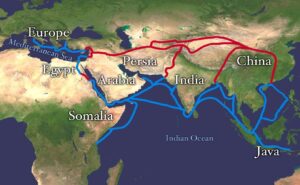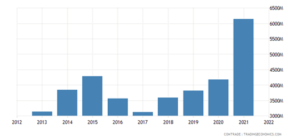Africa and China have had historic relations – from diplomatic relations to economic partnerships – dating back thousands of years. This can be traced way back to the ancient Chinese trade route known as the Silk Road during the 1st century BC to the mid-15th century. This was a very famous trade route in world history that connected China with East and Southeast Asia, the Indian subcontinent, Central Asia, the Middle East, East Africa and Europe.
For more than 1,500 years, the Silk Road created a network that extended approximately 6,437 kilometres across landscapes and seas. The traders had to pass through inhospitable deserts and dangerous oceans from south-east coastal areas of China to Mediterranean countries through central Asia; and through the China Peninsula, Chinese traders managed to reach Europe and East Africa.
Cities were built and established along the Silk Road in East Africa, such as Kilwa Kisiwani in south-eastern Tanzania – which was an important commerce and exchange centre. The city allowed Chinese merchants and traders to rest, sell, purchase and interact with other travelers – sharing not only tangible items but also talents, technology, art, traditions, languages and ideas.
Figure-1: East Africa Silk Road map

In 2013, President Xi Jinping was inspired to resurrect a contemporary silk economic route, and he launched a plan for a Silk Road Economic Belt and ‘21st Century Maritime Silk Road’ formally known as the Belt and Road Initiative (BRI). The Belt and Road Initiative (BRI) is a China-led infrastructure initiative with the goal of connecting countries across the world through physical infrastructure from Asia, Europe and Africa.
Impact of Belt and Road Initiative in East Africa
The Belt and Road Initiative has had a significant impact on East African economic growth, not only interconnecting the region through multi-billion-dollar infrastructure projects such as standard gauge railways, strategic roads, improving seaports and the construction of hydropower plants, but also enhancing cooperation in diverse sectors such as agriculture, education, finance, health, science and technology, with the goal of raising social-economic potential toward sustainability.
One of the global debates now is whether China is attempting to influence and dominate African countries through the Belt and Road Initiative. Some Western scholars went so far as to say that the China Belt and Road Initiative increased debts to African states, and that this is a strategic plan for neo-colonialism. However, most Western nations are unaware that the Belt and Road Initiative addresses common African difficulties like infrastructural problems, unemployment and improving regional commerce. China contributed 936.7 billion yuan as direct investment in states along the ‘Belt and Road Initiative’.
Today, China is Tanzania’s leading investor as well as major exporter of goods to the country. China’s exports to Tanzania were US$6.14billion in 2021 – making it the country’s fifth-largest export destination.
Figure-2: China Exports to Tanzania statistics

Following outbreak of the COVID-19 pandemic, China played a significant role in African economic recovery by establishing strategic projects and opening a window for African countries to export and import goods from large markets in China. Most Tanzanian business owners now prefer to import goods from China rather than the West, because there is no shipping barrier and the prices are more affordable.
The Belt and Road initiative in Tanzania accelerates industrialisation and attracts foreign investors: in 2021, China’s direct investment in Tanzania in non-financial sectors was US$53.75million. The development and rebuilding of Maweni Limestone Limited by China Huaxin Cement went into production successfully, making it the second-largest cement manufacturer in Tanzania with an annual output of 1.5 million tonnes - which provided important support for the industrialisation of Tanzania.
The increased number of Chinese investment firms in Tanzania encourages not only economic growth but also local industries, resulting in higher import and export rates. The BRI’s investment in transportation infrastructure, power and telecommunications encourages trade between regions and neighbouring countries. With excellent infrastructure and reduced trading time delays at borders, shipping and product transportation, a trader spends a short period transferring products from the maker to the ultimate consumer.
China actively assists African countries in addressing unemployment issues. According to Chinese statistics, Chinese enterprises have created more than 4.5 million jobs in African countries; of which about 150,000 are in Tanzania. China has also aided African countries in the establishment of vocational schools and provision of scholarships for study and short-term training in China.
As we conclude, it is clear that China’s growth and emergence as one of Africa’s main trade and investment partners should serve as a great lesson for African countries to keep in shape their economic strategic plans, market reform, and policies that not only solve political issues but also address fundamental challenges which deal with economic growth.
The author is a Senior Research Fellow (Tanzania), Africa-China Centre for Policy and Advisory and Lecturer, Ardhi University, Tanzania










